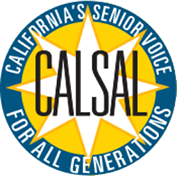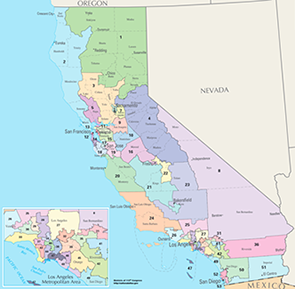California Senior Advocates League


Issues
The issues that California seniors care about are the issues that all Californians prioritize - affordable healthcare & housing, quality education & government services, and safe & thriving communities.
CalSAL supports policies that promote:
- Healthcare with high levels of benefits at affordable cost, including premiums, deductibles, co-payments and other out-of pocket expenditures.
- Economic prosperity, business development, and employment opportunities for young and old alike.
- Affordable housing through downtown residential development, maintaining and strengthening the infrastructure to support new housing, and resolution of construction disputes through negotiation, not litigation.
- Empowering individuals and communities to prevent crime and protect seniors from fraud and business scams.
- Responsible, responsive, and accountable government that provides critical public services, without unnecessary financial or social burdens, especially for seniors in need.

Ballot Initiatives
Increasingly state issues are being taken directly to voters at the ballot box.
Already four initiatives have qualified for, or are eligible for, the November 2022 mid-term election and cleared for circulation.
This list of topics includes qualified and those that are circulating but haven't yet qualified:
- Medical Negligence
- Recycling and Environmental Programs
- Native Indian Gaming
- Child Custody
- Labor Rights
- Police Reform

CalSAL has been a trusted voice for voters for the past 18 years on ballot measures.
In the November 2020 election CalSAL took positions on the following initiatives.
Proposition 15: “Split-roll” property tax increase.
CalSAL Position: OPPOSE - Outcome: Failed 52%
Proposition 19: Changes Requirements for Certain Property Owners To Transfer Their Property Tax Base To Replacement Property.
CalSAL Position: SUPPORT - Outcome: Passed 51%
Proposition 21: Expands Local Governments’ Authority To Enact Rent Control on Residential Property. CalSAL Position: OPPOSE - Outcome: Failed 60%
Proposition 22: App-Based Jobs and Services.
CalSAL Position: SUPPORT - Outcome: Passed 59%
Proposition 23: Dialysis Clinic Requirement.
CalSAL Position: OPPOSE - Outcome: Failed 63%
Proposition 25: Referendum to Overturn A 2018 Law That Replaced Money Bail System.
CalSAL Position: OPPOSE - Outcome: Failed 56%
Focus on Redistricting
Every ten years the US Census counts every person living in the United States. This data is then used for two purposes. First, it is used to apportion congressional seats amongst the states according to populations. Second, it is used by the states to draw new boundaries for state legislative and congressional districts.
California voters removed elected state legislators from the redistricting process in 2008 with Proposition 11 which created the California Citizens Redistricting Commission (CRC). In 2010, California voters added the responsibility of drawing Congressional districts to the CRC with Proposition 20. CalSAL enthusiastically and actively supported both Initiatives.
Voters should choose their representatives; elected representatives should not choose their voters. CalSAL knows that fair districts drawn to reflect the community are foundational for democracy to thrive and empowered civic engagement.
Final district boundaries will be in place for the 2022- 2030 election cycles using the following criteria:
- Population equality. Each district must have equal population to the extent practicable.
- Compliance with the federal Voting Rights Act. At its most basic, the Voting Rights Act requires that districts be drawn in which minority and historically disadvantaged populations can elect their own representation if they would not be able to do so without such a district. This is often called a minority-majority district.
- California has roughly 23 minority- majority Congressional districts reflecting the majority of African Americans, Asians, and Hispanics in those districts.
- Districts must be contiguous so that all parts of the district are connected to each other.
- Districts must respect the boundaries of cities, counties, neighborhoods and communities of Interest, and minimize their division, to the extent possible.
- Districts should be geographically compact, that is, have a fairly regular shape.
- Where practicable each Senate District should be comprised of two complete and adjacent Assembly Districts and Board of Equalization districts shall be composed of 10 complete and adjacent State Senate Districts.
- Districts shall not be drawn to favor or discriminate against an incumbent, candidate, or political party.
In California, we also elect the Board of Equalization members by district and these districts are also redrawn.

_a.jpg?crc=460894582)
Redistricting in California: